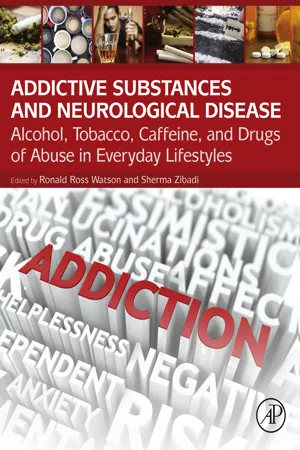
Addictive Substances and Neurological Disease
Alcohol, Tobacco, Caffeine, and Drugs of Abuse in Everyday Lifestyles
- 414 pages
- English
- ePUB (mobile friendly)
- Available on iOS & Android
Addictive Substances and Neurological Disease
Alcohol, Tobacco, Caffeine, and Drugs of Abuse in Everyday Lifestyles
About this book
Addictive Substances and Neurological Disease: Alcohol, Tobacco, Caffeine, and Drugs of Abuse in Everyday Lifestyles is a complete guide to the manifold effects of addictive substances on the brain, providing readers with the latest developing research on how these substances are implicated in neurological development and dysfunction.Cannabis, cocaine, and other illicit drugs can have substantial negative effects on the structure and functioning of the brain. However, other common habituating and addictive substances often used as part of an individual's lifestyle, i.e., alcohol, tobacco, caffeine, painkillers can also compromise brain health and effect or accentuate neurological disease.This book provides broad coverage of the effects of addictive substances on the brain, beginning with an overview of how the substances lead to dysfunction before examining each substance in depth. It discusses the pathology of addiction, the structural damage resulting from abuse of various substances, and covers the neurobiological, neurodegenerative, behavioral, and cognitive implications of use across the lifespan, from prenatal exposure, to adolescence and old age.This book aids researchers seeking an understanding of the neurological changes that these substances induce, and is also extremely useful for those seeking potential treatments and therapies for individuals suffering from chronic abuse of these substances.- Integrates current research on the actions of addictive substances in neurological disease- Includes functional foods, such as caffeine beverages, that have habituating effects on the brain- Provides a synopsis of key ideas associated with the consequences of addictive and habituating lifestyle substances
Frequently asked questions
- Essential is ideal for learners and professionals who enjoy exploring a wide range of subjects. Access the Essential Library with 800,000+ trusted titles and best-sellers across business, personal growth, and the humanities. Includes unlimited reading time and Standard Read Aloud voice.
- Complete: Perfect for advanced learners and researchers needing full, unrestricted access. Unlock 1.4M+ books across hundreds of subjects, including academic and specialized titles. The Complete Plan also includes advanced features like Premium Read Aloud and Research Assistant.
Please note we cannot support devices running on iOS 13 and Android 7 or earlier. Learn more about using the app.
Information
Acute Ethanol-Induced Changes in Microstructural and Metabolite Concentrations on the Brain
Noninvasive Functional Brain Imaging
Abstract
Keywords
Introduction
Alcohol and Neurological Dysfunction
Neuroimaging in Acute Ethanol Consumption
DTI- and DKI-Detected Acute Ethanol-Induced Changes on Microstructures in the Brain
Table of contents
- Cover image
- Title page
- Table of Contents
- Copyright
- List of Contributors
- Preface
- Acknowledgments
- Part I. Alcohol and Neurological Dysfunction
- Part II. Addictive Substances and Behavioral Health
- Part III. Tobacco Smoking in Neuromodulation
- Part IV. Drugs of Abuse and Brain Structure and Function
- Index